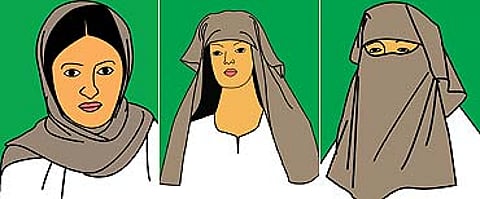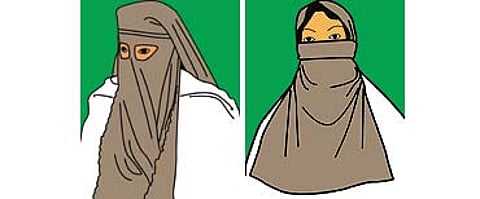Don't Show Me Your Face
Say the Deobandis to women. It's up to you, says the law board.


The Talibani purdah recommended by the Deobandis is, however, opposed by Dr Kalbe Sadiq, Shia cleric and vice-chairman of the law board. After the Shabana controversy broke, he stated publicly that while a woman should be modestly dressed, nowhere in the Quran was it stated that a woman should be in purdah and must cover her face.
The veil may be at the centre of a raging controversy in the West. But in India, where the ghunghat is common among many non-Muslims, modestly covering one's head is not really an issue. There is no all-India figure for the percentage of Muslim women who are veiled. But experts believe it would be a small figure. In Assam, West Bengal and Bihar, areas with huge Muslim populations, women rarely wear burqas. The sari is still worn by large numbers of Indian Muslims. Since most rural women would have to work in the fields, it is unlikely that they venture out in burqas. In North India, some burqa-clad women can be seen in Muslim ghettos.
Still, in a country so large it is impossible to make generalisations. For instance, a recent study in Kerala came up with some startling statistics. The Kerala Shastra Sahitya Parishad, a progressive science movement, found the purdah being adopted rather than abandoned by large numbers of Muslim women. A small survey done by the group found that in the past while only 10.3 per cent of the older generation of Muslims covered their heads, the figure has now gone up to 31.6 per cent. In the Malabar region, the purdah craze is at its extreme with women covering not just their heads but entire faces.
Popular Malayalam comedian Mamu Koya says: "I feel the purdah is turning into a big problem. It has been there for generations, but today's women are masking their entire faces and taking us back in time." The Gulf influence on Kerala's Muslims cannot be overlooked. The advent of Gulf money has also led to fashionable veils, some with intricate design, embroidery and lace. Q.R. Ilyas, the law board spokesman, says they have no figures but there is a general impression that more women are taking to the burqa because of increasing religiosity and the desire to stress the Islamic identity.
Such trends are impossible to quantify. Sociologist Imtiaz Ahmad says that while the majority of Indian Muslims are not in purdah, "it is prevalent among the lower middle classes in urban areas with aspirations towards social mobility". In other words, veiling a woman can at times be a status symbol.
There is another intriguing trend at work vis-a-vis the purdah. Ahmad believes the debate is also linked to what Muslims perceive as an attack by the West. "The discourse over the veil is old and couched in certain colonial rhetoric. This has led to a counter- rhetoric of the Muslims to negate the western stereotype. In many parts of the world today the veil is seen as a symbol of resistance against the West or western ideals. The Indian clergy too is part of that trend," he says.
This year's Nobel prize-winning novelist Orhan Pamuk's masterful work Snow is the tale of women donning the scarf in protest against the forced secular state of Turkey. But India is not Turkey, where secularisation was imposed by the republic's founder Kemal Ataturk. An Islamic identity may be the pursuit of some Muslims in India. But for the majority must know they are in a minority in this country. To be veiled or not is really their own choice. For a community falling backwards in socio-economic indicators it cannot be a priority issue.
Tags